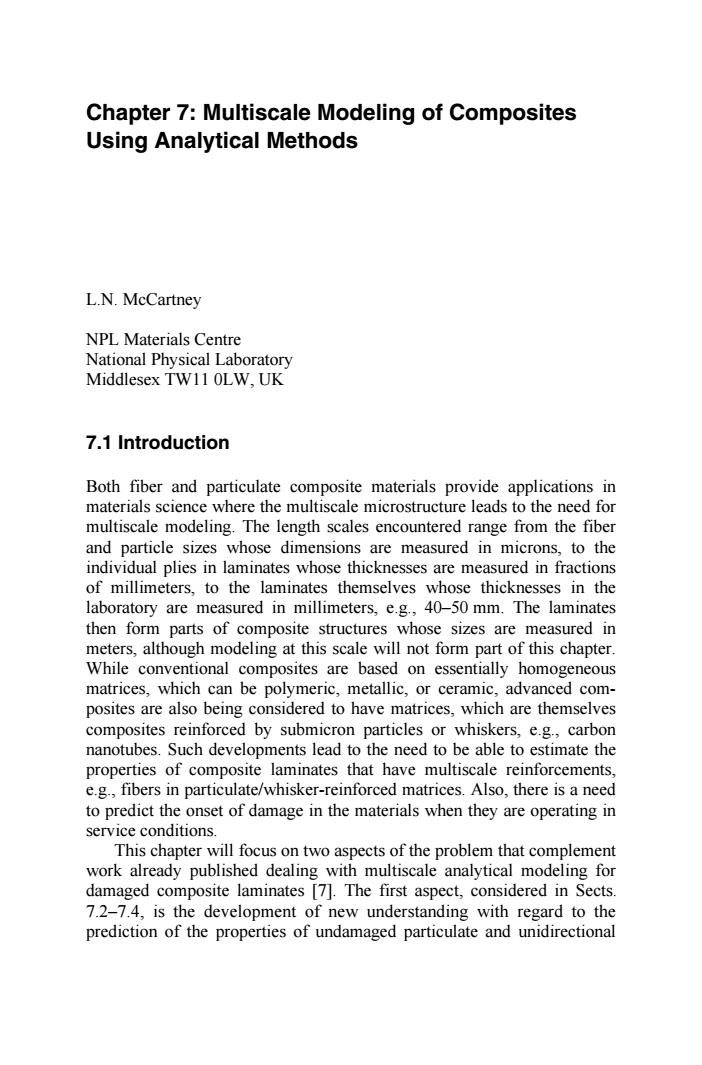正在加载图片...

Chapter 7:Multiscale Modeling of Composites Using Analytical Methods L.N.McCartney NPL Materials Centre National Physical Laboratory Middlesex TW11 OLW.UK 7.1 Introduction Both fiber and particulate composite materials provide applications in materials science where the multiscale microstructure leads to the need for multiscale modeling.The length scales encountered range from the fiber and particle sizes whose dimensions are measured in microns,to the individual plies in laminates whose thicknesses are measured in fractions of millimeters,to the laminates themselves whose thicknesses in the laboratory are measured in millimeters,e.g.,40-50 mm.The laminates then form parts of composite structures whose sizes are measured in meters,although modeling at this scale will not form part of this chapter. While conventional composites are based on essentially homogeneous matrices,which can be polymeric,metallic,or ceramic,advanced com- posites are also being considered to have matrices,which are themselves composites reinforced by submicron particles or whiskers,e.g.,carbon nanotubes.Such developments lead to the need to be able to estimate the properties of composite laminates that have multiscale reinforcements, e.g.,fibers in particulate/whisker-reinforced matrices.Also,there is a need to predict the onset of damage in the materials when they are operating in service conditions. This chapter will focus on two aspects of the problem that complement work already published dealing with multiscale analytical modeling for damaged composite laminates [7].The first aspect,considered in Sects. 7.2-7.4,is the development of new understanding with regard to the prediction of the properties of undamaged particulate and unidirectionalChapter 7: Multiscale Modeling of Composites Using Analytical Methods L.N. McCartney NPL Materials Centre National Physical Laboratory Middlesex TW11 0LW, UK 7.1 Introduction Both fiber and particulate composite materials provide applications in materials science where the multiscale microstructure leads to the need for multiscale modeling. The length scales encountered range from the fiber and particle sizes whose dimensions are measured in microns, to the individual plies in laminates whose thicknesses are measured in fractions of millimeters, to the laminates themselves whose thicknesses in the laboratory are measured in millimeters, e.g., 40–50 mm. The laminates then form parts of composite structures whose sizes are measured in meters, although modeling at this scale will not form part of this chapter. While conventional composites are based on essentially homogeneous matrices, which can be polymeric, metallic, or ceramic, advanced composites are also being considered to have matrices, which are themselves composites reinforced by submicron particles or whiskers, e.g., carbon nanotubes. Such developments lead to the need to be able to estimate the properties of composite laminates that have multiscale reinforcements, e.g., fibers in particulate/whisker-reinforced matrices. Also, there is a need to predict the onset of damage in the materials when they are operating in service conditions. This chapter will focus on two aspects of the problem that complement work already published dealing with multiscale analytical modeling for prediction of the properties of undamaged particulate and unidirectional damaged composite laminates [7]. The first aspect, considered in Sects. 7.2–7.4, is the development of new understanding with regard to the